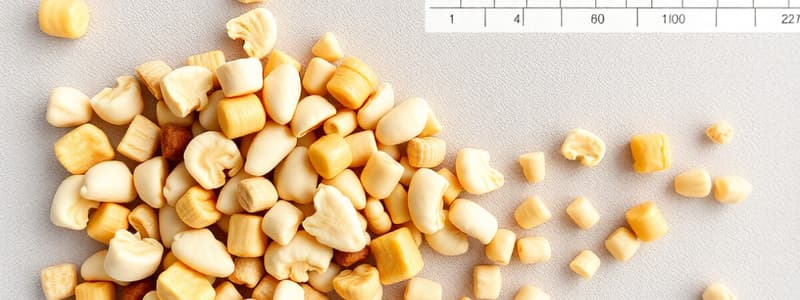Podcast
Questions and Answers
Why is accurate dry matter (DM) determination vital in feed analysis, and what impact does it have on the measurement of other proximate constituents?
Why is accurate dry matter (DM) determination vital in feed analysis, and what impact does it have on the measurement of other proximate constituents?
Accurate DM determination is essential because the reliability of measuring other proximate constituents depends on it. If the DM is not accurate, the subsequent measurements of crude ash, crude protein, ether extracts, etc., will also be inaccurate.
Explain the fundamental principle behind the Weende system of feed analysis and briefly describe its historical context.
Explain the fundamental principle behind the Weende system of feed analysis and briefly describe its historical context.
The Weende system, developed in 1865, chemically analyzes feed to determine its composition. It categorizes micronutrients into six groups: moisture, crude ash, crude protein, ether extracts, crude fiber, and nitrogen-free extract.
Describe the Kjeldahl method used for crude protein (CP) determination, and explain what it directly measures in the feed sample.
Describe the Kjeldahl method used for crude protein (CP) determination, and explain what it directly measures in the feed sample.
The Kjeldahl method is used to determine the crude protein (CP) content of a feed sample by measuring its total nitrogen content. This nitrogen value is then used to estimate the protein content.
For fermentable feeds, state the importance of the two-step drying procedure for DM determination, and briefly outline each step.
For fermentable feeds, state the importance of the two-step drying procedure for DM determination, and briefly outline each step.
Name at least three alternative methods (besides oven drying) that can be used to accurately determine moisture content in a feed sample.
Name at least three alternative methods (besides oven drying) that can be used to accurately determine moisture content in a feed sample.
In the Kjeldahl method, why is the digested material neutralized with an alkaline solution?
In the Kjeldahl method, why is the digested material neutralized with an alkaline solution?
Explain how the Kjeldahl method accounts for both true protein and non-protein nitrogen (NPN) in a sample.
Explain how the Kjeldahl method accounts for both true protein and non-protein nitrogen (NPN) in a sample.
Why is it important to perform the crude ash analysis in a muffled oven at a specific temperature range (550 to 600°C)?
Why is it important to perform the crude ash analysis in a muffled oven at a specific temperature range (550 to 600°C)?
In the crude fibre analysis, what is the purpose of boiling the ether extract fat-free residue in both acid and alkaline solutions?
In the crude fibre analysis, what is the purpose of boiling the ether extract fat-free residue in both acid and alkaline solutions?
Explain why the detergent system of feed analysis is increasingly important in both ruminant and non-ruminant research.
Explain why the detergent system of feed analysis is increasingly important in both ruminant and non-ruminant research.
Flashcards
Weende System
Weende System
A chemical analysis to determine feed composition, developed in 1865.
Weende System Categories
Weende System Categories
Six categories: moisture, crude ash, crude protein, ether extracts, crude fibre, and nitrogen-free extract.
Dry Matter (DM)
Dry Matter (DM)
Critical for accurate feed analysis. Determined by evaporating all moisture from the feedstuff.
Oven-Drying Temperature
Oven-Drying Temperature
Signup and view all the flashcards
Crude Protein (CP) Measurement
Crude Protein (CP) Measurement
Signup and view all the flashcards
Kjeldahl Method
Kjeldahl Method
Signup and view all the flashcards
Crude Protein (CP)
Crude Protein (CP)
Signup and view all the flashcards
Crude Ash
Crude Ash
Signup and view all the flashcards
Crude Fibre (CF)
Crude Fibre (CF)
Signup and view all the flashcards
Detergent System (Feed Analysis)
Detergent System (Feed Analysis)
Signup and view all the flashcards
Study Notes
- Proximate analysis is a chemical analysis method for determining the composition of animal feed.
- The proximate analysis system was developed in 1865 by Henneberg and Stohmann at the Weende Experimental Station in Germany.
- The system evaluates six categories of micronutrients: moisture, crude ash, crude protein, ether extracts, crude fibre, and nitrogen-free extract.
Water & Dry Matter (DM)
- Determining dry matter (DM) in feeds is critical because reliable measurements of other constituents depend on it.
- DM is determined by evaporating all moisture from the feedstuff.
- Most test material is dried at 100-135ºC until all water evaporates.
- Approved oven-drying methods include drying at 100ºC under vacuum, drying in a forced-air oven at 135ºC for two hours, or drying at 105°C for six hours.
- A two-step procedure involves determining a partial DM value by drying samples at 60ºC overnight, then applying AOAC methods.
- Alternative methods to determine moisture include toluene distillation, saponification, Karl Fischer method, gas chromatography, and Near-infrared reflectance spectroscopy (NIRS).
Crude Protein (CP)
- Crude Protein (CP) is determined using the Kjeldhal laboratory procedure, which measures the total nitrogen.
- The procedure involves digestion with sulphuric acid to convert nitrogen to ammonia.
- Ammonia gas is liberated when the ammonium sulphate precipitate is neutralized with an alkaline such as sodium hydroxide (NaOH).
- Ammonia is combined with boric acid to convert the gas to ammonium ions (ammonium borate).
- The nitrogen concentration is estimated by titrating ammonium borate with either sulphuric or hydrochloric acid.
- Percentage CP is obtained by multiplying the derived nitrogen figure by 6.25.
- Calculations assume that proteins contain approximately 16% nitrogen.
- The CP value encompasses both ‘true protein' and non-protein nitrogen (NPN) compounds such as free amino acids, ammonium salts, and urea.
Crude Ash
- Ash content is estimated by burning a pre-determined weight of the dry matter in a muffled oven at 550 to 600ºC to remove all organic matter.
- The leftover residue represents the inorganic and total mineral content of the sample.
- Trace elements like selenium, lead, and cadmium may be volatilized during ashing.
- Proximate ash analysis is a preliminary step to specific mineral analysis using specialized equipment.
Crude Fibre (CF)
- Proximate analysis of crude fibre estimates less soluble, fibrous fractions associated with feed carbohydrates.
- The procedure involves boiling ether extract fat-free residue in acid solution before rinsing, then with sodium hydroxide and rinsing again.
- Lastly, the residue is dried, weighed, ashed, and re-weighed.
- Crude fibre content is calculated as the difference between the pre-ash and post-ash weight.
- The detergent system of feed analysis was developed by Peter Van Soest in the 1960s.
- Plant cells are divided into less digestible cell walls (hemicellulose, cellulose and lignin) and digestible cell content (starch and sugars).
- These components are separated by using a neutral detergent and an acid detergent.
- Neutral Detergent Fibre (NDF) is a good indicator of bulk.
- Acid Detergent Fibre (ADF) is a good indicator of digestibility.
Ether Extract (EE)/Crude Fat
- Ether extract/crude fat analysis evaluates the amount of lipids in feeds.
- Oven-dried samples are ground and extracted with an organic solvent such as diethyl ether, and the remaining residue is dried and weighed.
- Ether extract is determined to be the difference between the original dried sample and the ether extract residue.
Nitrogen-Free Extract (NFE)
- Nitrogen-Free Extract represents a mixture of constituents not determined in the previous.
- The NFE fraction mostly contains starches, sugars, pectins, and hemi-cellulose.
- The percentage of NFE is calculated by subtracting the sum of moisture, crude protein, crude fiber, ash and ether extract (expressed as a percentage) from one hundred (100).
Proximate Analysis Limitations
- Shortcomings are evident in the analyses of ash, crude fibre, crude protein, and nitrogen-free extract constituents.
- The remaining residual ash after ignition and burning of the dry matter sample is not truly reflective of inorganic material in food
- Ashing process drawbacks include loss of inorganic material through volatilization, and presence of contaminants like silica and carbon.
- Analysis fails to provide quantitative information on specific minerals in feed.
- Alternative methods include 'wet ashing' and spectrophotometric analysis.
- Inadequacies in the crude fibre and nitrogen-free extract fractions have been addressed by the development and utilization of the detergent-based analytical system.
- The detergent system was devised by V.J. Van Soest and divides feeds into two parts:
- A high digestible fraction (plant cell contents) made up of sugar, starches, soluble protein, pectin and lipids
- A variable digestible fraction (plant cell wall contents) comprised of insoluble protein, hemi-cellulose, cellulose, lignin and bound nitrogen.
- Final products of the detergent system are neutral detergent solubles (cell contents) and neutral detergent fibre (cell wall components).
- Crude protein analysis using is based on the faulty premise that the average nitrogen content of crude protein in forages and feed is always 16%.
- Modern procedures such as the enhanced Dumas method (combustion elemental analysis) and UV-visible spectroscopy have vastly improved the efficiency and accuracy of measuring total nitrogen and protein in various feeds.
Detergent Method of Forage Analysis (Van Soest Method)
- The generally unsatisfactory nature of the Weende method for estimating the crude fiber content of foods and feeds has been recognized for many years.
- The Van Soest method of fiber analysis is a widely used system for determining the fiber content of plant materials for animal nutrition studies.
- It was developed by Peter J. Van Soest
- Offers a more detailed breakdown of fiber components compared to crude fiber analysis.
- The concept behind detergent fiber analysis is that plant cells can be divided into less digestible cell walls (contains hemicellulose, cellulose and lignin) and mostly digestible cell contents (contains starch and sugars).
- Two detergents are used: a neutral detergent (Na-lauryl sulfate, EDTA, pH =7.0) and an acid detergent (cetyl trimethyl ammonium bromide in 1 N H2SO4).
- Hemicellulose, can be partially digestible in ruminants.
- Hemicellulose, cellulose and lignin are indigestible in non-ruminants
- NDF = Hemicellulose + Cellulose + Lignin
- ADF =Cellulose + Lignin
- Neutral Detergent Fiber is a good indicator of "bulk" and feed intake.
- Acid detergent fiber is a good indicator of digestibility and energy intake
Principles of Energy Partitioning
- Energy is the capacity to do work and exists in chemical, mechanical, and heat forms.
- The energy absorbed by an animal is in the nutrients (VFAs, amino acids, glucose, and lipids).
- The unit of energy is the joule (J).
- There are 4.184 joules in a calorie
- 10^6 J = 1 megajoule (MJ).
Gross Energy (GE)
- Gross energy is the total amount of energy in food.
Digestible Energy (DE)
- Digestible energy (DE) refers to the amount of energy that is actually absorbed by an animal after digestion.
- DE represents the difference contained in the food and that lost in the faeces.
Metabolizable Energy (ME)
- Metabolizable energy is the energy remaining for the cow to use for metabolic processes.
- The loss of energy in urine and methane is approximately 19% of DE.
- ME = 0.81 DE
Heat Increment (HI)
- When ME is converted to net energy (NE), heat is generated by a number of processes. The HI is sometimes referred to as the specific dynamic action of food.
- The efficiency of converting ME to NE is given the symbol k. K = NE/ME
- Two important points about efficiency of converting ME to NE: It varies depending on the ME content of the diet and the purpose for which the NE is used.
Net Energy (NE)
- Energy required at the tissue level for maintenance, growth, milk synthesis, etc. is referred to as net energy.
- Energy requirements are expressed in units of ME.
- Animals can also obtain NE for maintenance, lactation, or gestation by mobilizing stored body protein and fat.
Studying That Suits You
Use AI to generate personalized quizzes and flashcards to suit your learning preferences.



